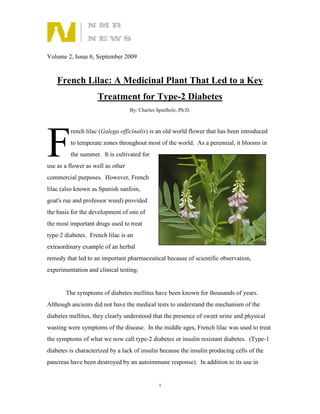
French Lilac Article Sep 2009
- 1. Volume 2, Issue 6, September 2009 1 French Lilac: A Medicinal Plant That Led to a Key Treatment for Type-2 Diabetes By: Charles Spielholz, Ph.D. rench lilac (Galega officinalis) is an old world flower that has been introduced to temperate zones throughout most of the world. As a perennial, it blooms in the summer. It is cultivated for use as a flower as well as other commercial purposes. However, French lilac (also known as Spanish sanfoin, goat's rue and professor weed) provided the basis for the development of one of the most important drugs used to treat type-2 diabetes. French lilac is an extraordinary example of an herbal remedy that led to an important pharmaceutical because of scientific observation, experimentation and clinical testing. The symptoms of diabetes mellitus have been known for thousands of years. Although ancients did not have the medical tests to understand the mechanism of the diabetes mellitus, they clearly understood that the presence of sweet urine and physical wasting were symptoms of the disease. In the middle ages, French lilac was used to treat the symptoms of what we now call type-2 diabetes or insulin resistant diabetes. (Type-1 diabetes is characterized by a lack of insulin because the insulin producing cells of the pancreas have been destroyed by an autoimmune response). In addition to its use in F
- 2. Volume 2, Issue 6, September 2009 2 treating diabetes, people of medieval Europe also used French lilac to treat a variety of other aliments including plague, worms, animal bites, poisoning, dysuria (painful urination) and even miasma (bad odor). French lilac was also used to increase milk production in certain domesticated farm mammals (hence the genus name Galenga). But it was the ability of French lilac to reverse the symptoms of diabetes mellitus that caught the attention of the biomedical community in modern times.1 Analysis of the chemical composition of French lilac in the late 1800's indicated that the plant contained significant amounts of guanidine. By the early 1900's, it was shown that this molecule had the ability to lower blood glucose levels in laboratory animals. Unfortunately, guanidine itself was quite toxic causing extracts of French lilac high in guanidine to not be useful for treating diabetes mellitus. For a short time, a less toxic extract of French lilac rich in a related molecule, known as galegine, was used to treat diabetics.2,3,4 The toxicity of guanidine, however, actually stimulated the development of a class of compounds related to guanidine called the diguanides. Clinical testing showed that the diguanides were antigylcemic and were also less toxic then guanidine. Diguanides were used to treat the symptoms of diabetes mellitus in the first half of the twentieth century. The diguanides were displaced by the discovery of insulin. Administration of high concentrations of insulin to insulin resistant diabetics forced the insulin pathway to respond basically because of mass action. High concentrations of insulin forced the binding of hormone to receptor. However, a simple to use antiglycemic drug in tablet form that would exhibit few adverse side effects was still being researched at the
- 3. Volume 2, Issue 6, September 2009 3 chemical level. The next generation of antiglycemic drugs to be developed from that research occurred around 1930 and was called the biguanides. The biguanides were proven to be non-toxic in laboratory animals. Starting in the late 1940's and throughout much of the 1950's, chemical modifications and clinical trials performed in France lead to the development of the biguanide drug metformin. In 1957, metformin was introduced to the scientific and clinical world. Its use was first approved for treatment of diabetes in France in 1979. It is still used around the world today.5,6 The similarity of guanidine to metformin is shown in the accompanying figure of chemical structures. The similarity of the structures of the two molecules is striking. Metformin is non-toxic derivative of the natural molecule isolated from a botanical. Metformin decreases blood glucose levels without significant adverse side effects. Metformin also decreases the death rate of diabetics with heart disease or who are obese. This important antiglcemic drug was developed based on scientific observations of a botanical/herbal remedy used in the middle ages. Although the development of metformin took about 70 years from the time guadinine was first isolated from French lilac, that time course would be much shorter in the present because of the advances made in both chemistry and biochemistry. Molecular structure of Metformin Molecular structure of Guanidine
- 4. Volume 2, Issue 6, September 2009 4 It is important to note that even with all the research and development of metformin, the exact biological mechanism by which it exerts it antiglycemic effects is still not understood. Without a biological explanation for the function of metformin means that the drug could not be designed by biochemists. Metformin was discovered because of excellent biological and chemical research coupled with clinical studies based on the careful scientific observations regarding the efficacy of a medieval herbal preparation on diabetes mellitus. References 1) Bailey CJ, Day C. Traditional plant medicines as treatments for diabetes. Diabetes Care. 1989 Sep;12(8):553-564. 2) Watanabe CK. Studies in the metabolic changes induced by administration of guanidine bases. J Biol Chem. 1918 33:253-265. 3) Sterne J. Pharmacology and mode of action of the hypoglyaemic guanidine derivatives. In Oral Hypoglaemic Agents. Campell GD (ed.) London: Academic Press. 1969 pp 193-245 4) Beckman R. Biguanide. In Handbook of Experimental Pharmacology. Maske H (ed.) Berlin: Springer Verlag. 1971 pp 439-596. 5) Sterne J. Du nouveau dans les antidiabetiques. La NN dimethylamine guanyl guanide. Maroc Med. 1957 Sep;36(388):873-884 6) Ungar G, Freedman L, Shapiro SL. Pharmacological studies of a new oral hypoglycemic drug. Proc Soc Exp Biol Med. 1957 May;95(1):190-192.